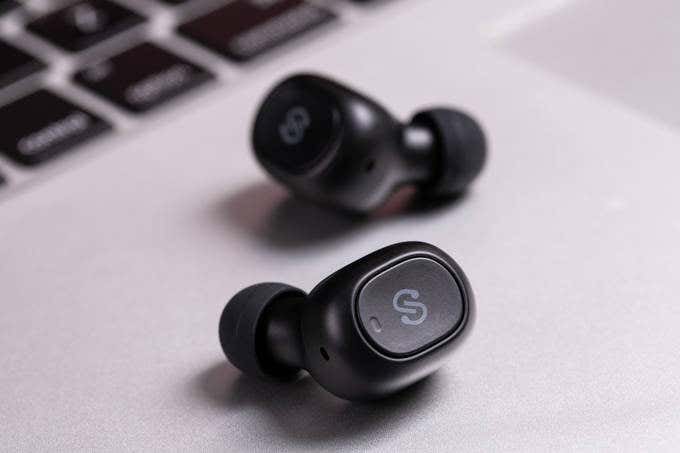The 3.5mm version came about in the 1950s and is still widely in use today. This means you could take a pair of headphones from almost three-quarters of a century ago and use them with a smartphone from 2019. That is unless you’ve bought one of the smartphone flagships of 2019. It’s been a long time coming but smartphone manufacturers are starting to drop the venerable headphone jack entirely. This has lead to much wailing and gnashing of teeth, but eventually the plucky little sound-hole is likely to end up as a quaint bit of tech history. We aren’t there yet however and as a brave adopter of cutting edge mobile technology, you’re suddenly in a situation where 99% of the audio accessories you own are no longer compatible with your shiny new phone. That’s especially painful if you’ve invested in high-end headphones that are perfectly functional, but need a headphone jack to work. So what now? We’ll get to that in a moment, but first let’s talk about why the humble jack is going the way of the dodo.
Why Is The Headphone Jack Disappearing?
There are plenty of reasons why a smartphone engineer would like to get rid of the headphone jack. Some of them are good for consumers, others are good for the bottom line of the manufacturer. Taken as a whole, they add up to clear signs that things are going to change. The first big reason is of course that the headphone jack takes up quite a lot of space in a device where every cubic millimeter counts. The headphone jack only does one job, so it’s an expensive sacrifice from a design point of view. The jack also limits how thin phones can be, although how much thinner phones need to be from a consumer point of view is an open question. Apart from incredible thinness, dumping the headphone jack makes it easier to waterproof a device. It’s one major source of ingress no one has to worry about anymore. It also means that the USB-C – or lightning port – (depending on your allegiance) can now handle audio duties with hardware that was already there whether you have the jack or not. That means manufacturers are removing a major source of redundancy. The list of arguments for removing the jack is quite long, but these are enough to highlight that the writing’s on the wall. So if we can all agree that a jack-less future is inevitable, let’s look at how to get with the program.
Dongles
Yes #DongleLife is no longer restricted to fans of Apple, with phones like the Samsung Note 10 and 10+ ditching the headphone jack as well. Your best interim solution is to buy an adapter that converts either your USB-C or Lighting connector to a 3.5mm TRS jack. If you buy a simple adapter that only provides a jack, you’ll have to forego wired charging while using it. This can be a pain if you’re using the phone in a car, so consider getting one of the slightly more expensive dongles that can both charge your device and provide legacy audio support at the same time. While you’re at it, you may even opt for a model that provides HDMI, USB-A or an SD-card reader. It’s a shame to waste all that bandwidth just waiting to be tapped from modern ports, after all. Just be sure to pick a product from a reputable brand. There have been some shenanigans with proper USB-C certification in particular, so it’s worth doing a bit of homework before clicking the “buy” button.
Buy a Bluetooth Adapter
It turns out that there’s a way to keep using your existing audio equipment and take advantage of modern wireless digital audio. Just buy a Bluetooth audio adapter. These devices are essentially the Bluetooth and audio hardware bit of Bluetooth headphones and speakers. They have a 3.5mm jack to which you can connect whatever you like. Pair your phone with the adapter, plug in your favorite audio device and jam out to some tunes. You can buy adapters that plug into your car’s 12V socket or USB. Battery-powered models can be clipped to your shirt. It’s the best-of-both-worlds approach with the minor annoyance of what to do with the excess wiring. It may be more expensive than a dongle, but it works with any Bluetooth audio device, of which there are far more than USB-C or Lighting audio devices.
Take The Wireless Headphone Plunge
If you aren’t attached to a current set of headphones, then it might be well to move on and change to wireless Bluetooth headphones. While you may think that these are all expensive (exhibit A being the AirPods) there are now wireless headphones at every price point. Of course, you get what you pay for in terms of sound quality, but Bluetooth itself is mature enough that even the cheapest wireless cans aren’t much more expensive than their wired peers. The premium option is to invest in some independent, true wireless buds, but just about every form of headphone is represented in wireless form. Even better, the battery life on most modern wireless headphones can be measured in days. Thanks to the latest low-energy revision of Bluetooth technology.
The Stages Of Grief
It’s understandable to feel a sense of loss when such a stalwart friend as the humble headphone jack shuffles off this mortal coil. It’s OK to feel a little bummed, but the jack would want us all to move on with our lives and embrace change. Alternatively, you could hold on to your old smartphone forever, but we really wouldn’t recommend it.




